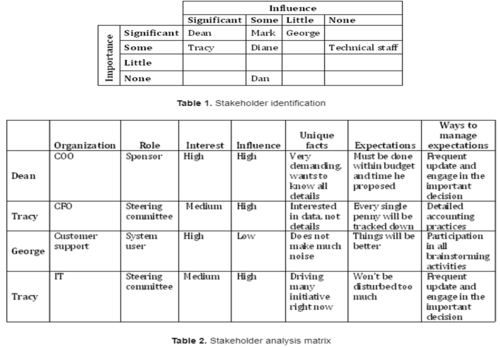Stakeholder
Business Doctionary defines Stakeholder as "A person, group or organization that has interest or concern in an organization. Stakeholders can affect or be affected by the organization's actions, objectives and policies."[1]
The international standard providing guidance on social responsibility, ISO 26000, defines a stakeholder as an “individual or group that has an interest in any decision or activity of an organization.”
Stakeholders can be internal or external. Internal stakeholders are people whose interest in a company comes through a direct relationship, such as employment, ownership or investment. External stakeholders are those people who do not directly work with a company but are affected in some way by the actions and outcomes of said business. Suppliers, creditors and public groups are all considered external stakeholders.[2]
Types of Stakeholders
Types of stakeholders include:
- Primary: those who are directly affected, either positively or negatively, by an organization’s actions
- Secondary: those who are indirectly affected by an organization’s actions
Stakeholder Analysis[3]
Stakeholder analysis is defined as a tool organizations can use to clearly identify key stakeholders for a project or other activity, understand where stakeholders stand, and develop cooperation between the stakeholders and the project team. The main objective is to ensure successful outcomes for the project or the changes to come. Stakeholder analysis is frequently used during the preparation phase of a project and is an excellent way to assess the attitudes of stakeholders towards changes or critical actions. It can be done once or on a regular basis to track changes in stakeholder attitudes over time. The stakeholder analysis is generally considered a highly confidential document because it often contains sensitive information.
Benefits of Creating a Stakeholder Analysis
- Provides clear understanding of stakeholders’ interests
- Offers mechanisms to influence other stakeholders
- Enables full understanding of potential risks
- Identifies key people to be informed about the project during the execution phase
- Provides awareness of negative stakeholders as well as their adverse effects on the project
Stakeholder Analysis Matrix
- Step 1. Stakeholder identification: Create a stakeholder matrix (Table 1) that will be used to identify key stakeholders and their positions. List the level of “influence” on the X axis (top row) and the level of “importance” on the Y axis (first column).
- Step 2. List all key stakeholders in the appropriate cells (Table 1).
- Step 3. Stakeholder analysis: Create a second matrix (Table 2). List all key stakeholders in the first column. List relevant information regarding them in the top row, using as many columns as needed.
- Step 4. Complete the information in the table by conducting interviews or through discussions with the project sponsor or another high- level resource.
- Step 5. Prepare an action plan to engage the stakeholders who could have a negative impact on the project or could be severely impacted by the actions.
The Stakeholder Debate[4]
In the field of Corporate Governance and Corporate_Social_Responsibility_(CSR), a debate is ongoing about whether the firm or company should be managed primarily for stakeholders, Shareholder, Customer, or others. Proponents in favour of stakeholders may base their arguments on the following four key assertions:
1) Value can best be created by trying to maximize joint outcomes. For example, according to this thinking, programs that satisfy both employees' needs and stockholders' wants are doubly valuable because they address two legitimate sets of stakeholders at the same time. There is evidence that the combined effects of such a policy are not only additive but even multiplicative. For instance, by simultaneously addressing customer wishes in addition to employee and stockholder interests, both of the latter two groups also benefit from increased sales.
2) Supporters also take issue with the preeminent role given to stockholders by many business thinkers, especially in the past. The argument is that debt holders, employees, and suppliers also make contributions and thus also take risks in creating a successful firm.
3) These normative arguments would matter little if stockholders (shareholders) had complete control in guiding the firm. However, many believe that due to certain kinds of board of directors structures, top managers like CEOs are mostly in control of the firm.
4) The greatest value of a company is its image and brand. By attempting to fulfill the needs and wants of many different people ranging from the local population and customers to their own employees and owners, companies can prevent damage to their image and brand, prevent losing large amounts of sales and disgruntled customers, and prevent costly legal expenses. While the stakeholder view has an increased cost, many firms have decided that the concept improves their image, increases sales, reduces the risks of liability for corporate negligence, and makes them less likely to be targeted by pressure groups, campaigning groups and NGOs.
A corporate stakeholder can affect or be affected by the actions of a business as a whole. Whereas shareholders are often the party with the most direct and obvious interest at stake in business decisions, they are one of various subsets of stakeholders, as customers and employees also have stakes in the outcome. In the most developed sense of stakeholders in terms of real corporate responsibility, the bearers of externalities are included in stakeholdership.
- ↑ Definition = What does Stakeholder Mean? Bisoness Dictionary
- ↑ Internal and External Stakeholders Investopedia
- ↑ Stakeholder Analysis: Benefits and Matrix Asq.org
- ↑ The Stakeholder Debate in corporate responsibility Wikipedia

